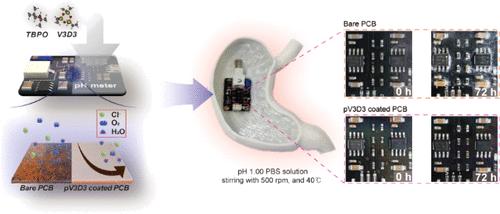当前位置:
X-MOL 学术
›
ACS Appl. Mater. Interfaces
›
论文详情
Our official English website, www.x-mol.net, welcomes your
feedback! (Note: you will need to create a separate account there.)
Robust Anticorrosive Polymer Thin Film for Reliable Protection of Ingestible Devices
ACS Applied Materials & Interfaces ( IF 8.3 ) Pub Date : 2024-11-19 , DOI: 10.1021/acsami.4c14344 Booseok Jeong, Seo Jin Kim, Jemin Yeun, Jihoon Lim, Nahyun Park, Aram Bae, Jueun Kim, Oh Seok Kwon, Bong Gill Choi, Sung Gap Im, Kyoung G. Lee
ACS Applied Materials & Interfaces ( IF 8.3 ) Pub Date : 2024-11-19 , DOI: 10.1021/acsami.4c14344 Booseok Jeong, Seo Jin Kim, Jemin Yeun, Jihoon Lim, Nahyun Park, Aram Bae, Jueun Kim, Oh Seok Kwon, Bong Gill Choi, Sung Gap Im, Kyoung G. Lee

|
Ingestible devices (ID) provide a safe and noninvasive method for monitoring, diagnosing, and delivering drugs to specific sites in the human body, particularly within the gastrointestinal (GI) tract. However, the GI environment is highly acidic and humid, which can cause IDs to fail, and their corrosion in the acidic environment can cause leaching of toxic metal ions, thereby substantially limiting their long-term use. Thus, an efficient method is required to protect IDs, especially in the chemically and mechanically harsh GI environment. However, an anticorrosive polymer coating that can safeguard IDs in the GI environment without delamination or performance degradation has not been developed to date. The protective layer must satisfy several critical requirements, e.g., high biocompatibility, mechanical durability, and superior anticorrosion performance. This paper reports a highly cross-linked but submicron-thick siloxane-based anticorrosive polymer thin film that can be deposited directly onto IDs without damaging them. The 500 nm-thick cross-linked polymer coating demonstrates exceptional corrosion resistance and chemical and mechanical stability in the GI environment without cytotoxicity. A printed circuit board (PCB) coated with the developed ultrathin protective film sustained performance after exposure to a pH 1.00 phosphate buffered saline solution at 37 °C for 72 h without leaching of metal ions. The ID continued to operate effectively under such challenging conditions; thus, the developed film is suitable for applications that require prolonged functionality, e.g., diagnostics, drug delivery, and continuous health monitoring in the GI tract.
中文翻译:

坚固的防腐聚合物薄膜,为可吞食设备提供可靠保护
可摄入设备 (ID) 提供了一种安全且无创的方法,用于监测、诊断和将药物输送到人体的特定部位,尤其是胃肠道 (GI) 内。然而,GI 环境是高酸性和湿度的,这可能导致 ID 失效,它们在酸性环境中的腐蚀会导致有毒金属离子的浸出,从而大大限制它们的长期使用。因此,需要一种有效的方法来保护 ID,尤其是在化学和机械恶劣的 GI 环境中。然而,迄今为止尚未开发出一种可以在 GI 环境中保护 ID 而不会分层或性能下降的防腐聚合物涂层。保护层必须满足几个关键要求,例如高生物相容性、机械耐久性和卓越的防腐性能。本文报道了一种高度交联但亚微米厚的硅氧烷基防腐聚合物薄膜,可以直接沉积在 ID 上而不会损坏它们。500 nm 厚的交联聚合物涂层在 GI 环境中表现出卓越的耐腐蚀性以及化学和机械稳定性,且无细胞毒性。涂有显影超薄保护膜的印刷电路板 (PCB) 在 37 °C 的 pH 1.00 磷酸盐缓冲盐水溶液中暴露 72 小时后仍能保持性能,而不会浸出金属离子。在这种充满挑战的条件下,ID 继续有效运作;因此,开发的薄膜适用于需要长时间功能的应用,例如诊断、药物输送和胃肠道的持续健康监测。
更新日期:2024-11-19
中文翻译:

坚固的防腐聚合物薄膜,为可吞食设备提供可靠保护
可摄入设备 (ID) 提供了一种安全且无创的方法,用于监测、诊断和将药物输送到人体的特定部位,尤其是胃肠道 (GI) 内。然而,GI 环境是高酸性和湿度的,这可能导致 ID 失效,它们在酸性环境中的腐蚀会导致有毒金属离子的浸出,从而大大限制它们的长期使用。因此,需要一种有效的方法来保护 ID,尤其是在化学和机械恶劣的 GI 环境中。然而,迄今为止尚未开发出一种可以在 GI 环境中保护 ID 而不会分层或性能下降的防腐聚合物涂层。保护层必须满足几个关键要求,例如高生物相容性、机械耐久性和卓越的防腐性能。本文报道了一种高度交联但亚微米厚的硅氧烷基防腐聚合物薄膜,可以直接沉积在 ID 上而不会损坏它们。500 nm 厚的交联聚合物涂层在 GI 环境中表现出卓越的耐腐蚀性以及化学和机械稳定性,且无细胞毒性。涂有显影超薄保护膜的印刷电路板 (PCB) 在 37 °C 的 pH 1.00 磷酸盐缓冲盐水溶液中暴露 72 小时后仍能保持性能,而不会浸出金属离子。在这种充满挑战的条件下,ID 继续有效运作;因此,开发的薄膜适用于需要长时间功能的应用,例如诊断、药物输送和胃肠道的持续健康监测。































 京公网安备 11010802027423号
京公网安备 11010802027423号